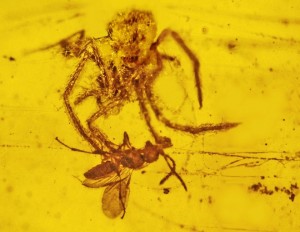100 Million Year Old Spider Attack Preserved Forever in Amber
Here’s a pretty remarkable and relatable image to take in. We’ve all seen the ancient insect preserved perfectly in amber, but never have we seen what is essentially a live look at an ancient predator at work.
In what scientists are calling a 100 million year old discovery, a social orb-weaver spider can be seen on the brink of attacking a parasitic wasp. Both of these exact species are extinct today, but remarkable similarities can be seen to current insects in both in their appearance and behavior.
This fossil, the first of it’s kind, is the result of impeccable timing. Tree resin was able to engulf the prey and the predator just as a final showdown was going down. Not only that, the artifact shed some light on the ancient social structure of spiders.
Aside from showing the first and only fossil evidence of a spider attacking prey in its web, the piece of amber also contains the body of a male spider in the same web. This provides the oldest evidence of social behavior in spiders, which still exists in some species but is fairly rare. Most spiders have solitary, often cannibalistic lives, and males will not hesitate to attack immature species in the same web.
Scientists attribute this relic to the Early Cretaceous period, sometime approximately 97 to 110 million years ago! This ancient spider attack was uncovered in the Hukawng Valley of Myanmar “almost certainly with dinosaurs wandering nearby”.
Science is cool.
Oregon State College of Science, TAndFOnline
Comments
Tags: 100 million year old, cretaceous period, insect fossil, insect in amber, insect preserved in amber, spider attack, spider attack in amber, spider vs. wasp
Trackback from your site.

